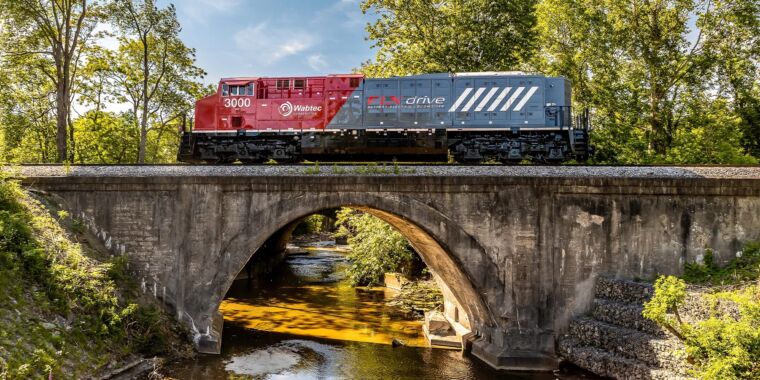Last week, Union Pacific Railroad agreed to buy 20 battery-electric freight locomotives from Wabtec and Progress Rail. The deal, which drew praise from President Biden, is worth more than $100 million. The battery-electric locomotives initially will be used to sort train cars in rail yards in California and Nebraska.

Battery-electric locomotives have already begun rolling on California tracks. As part of a demonstration with the Pacific Harbor Line, Progress Rail, a Caterpillar company, began operating battery-electric locomotives in the ports of Los Angeles and Long Beach late last year.
Also last year, Wabtec tested its FLXdrive locomotives on 18 trips between Barstow and Stockton, California, under a $22 million grant from the California Air Resources Board. The battery-electric locomotive sat between two traditional diesel locomotives, pulling as much as 430,000 pounds. Wabtec CTO Eric Gebhardt says the combination saved an average of 11 percent on fuel and emissions. Wabtec says its next-generation battery locomotive will nearly triple its energy storage capacity to 7 megawatt-hours, nearly 100 times the capacity of a Tesla Model 3. That could cut emissions by up to 30 percent, Gebhardt says.
Switching to battery-electric power will reduce greenhouse gas emissions and improve local air quality. Diesel locomotives spew particulate matter and other toxic pollutants, accounting for an estimated 1,000 premature deaths and $6.5 billion in health costs a year in the US. A spokesperson for the California Air Resources Board says replacing diesel locomotives will “undoubtedly have a positive health impact to nearby communities” and will represent “a step forward in the long-standing environmental justice concerns of communities living near rail yards in our state.”
Last fall, researchers from Lawrence Berkeley National Laboratory and UCLA’s Institute of the Environment and Sustainability predicted that retrofitting traditional diesel locomotives with battery power could save railroads $94 billion in fuel costs over 20 years, after buying the batteries, and would keep tons of pollutants out of the air. Trains in the US are especially well-suited for retrofitting with battery power because most locomotives use a diesel generator but have electric motors.
“This is the beauty. Because they already are electric, if someone decides to do it they can do it in a month,” says coauthor Amol Phadke, who studies heavy-duty electric vehicles and grid-scale battery storage. “All you’re doing is adding a railcar which has a huge amount of batteries on it.”
Taking battery, diesel, and electricity prices into account, the researchers estimate that adding a car with a 14-MWh battery to a train with four diesel locomotives could cut fuel costs in half. Getting battery-electric locomotives into service quickly is a big deal, since traditional diesel locomotives can operate for more than 20 years, Phadke says.





